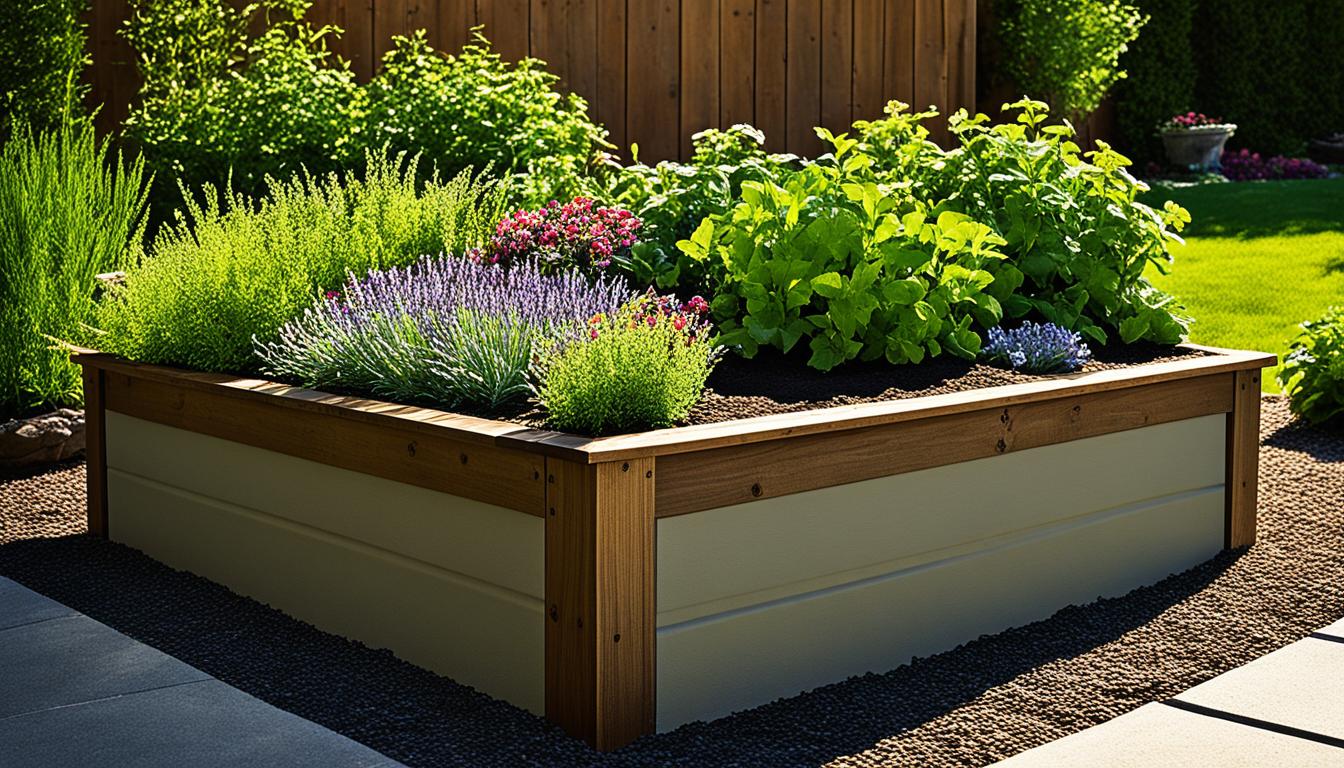Welcome to the world of raised garden beds, where your gardening dreams take root and flourish. If you’re looking to enhance your gardening experience and reap bountiful harvests, a raised garden bed is the way to go. In this article, we’ll explore the benefits of raised garden beds and provide tips for creating your own DIY raised garden bed.
With a raised garden bed, you’ll enjoy improved drainage and deeper, looser soil, resulting in healthier and more productive plants. Say goodbye to compacted soil and hello to better yields. Whether you have a small backyard or a spacious garden, a raised garden bed can be customized to fit your space and preferences.
Don’t worry if you’re new to gardening or DIY projects. Building a raised garden bed is easier than you think, and the rewards are well worth the effort. Let’s dive into the world of raised garden beds and get ready to take your gardening to new heights.
Key Takeaways:
- Raised garden beds offer improved drainage and soil quality, resulting in better plant growth and yields.
- You can create your own DIY raised garden bed, customizing it to fit your gardening space and preferences.
- A raised garden bed is a great option for both beginner gardeners and experienced enthusiasts.
- Building a raised garden bed is a rewarding and relatively simple DIY project.
- With a raised garden bed, you’ll enjoy easier access to your plants and reduced maintenance.
The Benefits of Raised Garden Beds
Raised garden beds offer several advantages for gardeners. They provide a convenient and efficient way to grow plants, allowing you to take full control of your gardening space. Here are some key benefits of raised garden beds:
1. Eliminate the need for tilling
Unlike traditional gardening methods, raised garden beds do not require tilling. This means less manual labor and a smoother gardening experience. You can simply fill the raised bed with nutrient-rich soil and start planting.
2. Improve soil quality
The soil in raised garden beds tends to be looser and more fertile compared to the ground soil. Raised beds allow for better drainage and root aeration, leading to healthier plant growth and higher yields.
3. Better control of drainage and water retention
One of the advantages of raised garden beds is that you can easily control the drainage and water retention levels. By using the right soil mix and adjusting the bed’s height, you can ensure that your plants receive just the right amount of water.
4. Reduce soil compaction
Since raised garden beds have defined edges, you don’t need to step on the soil, preventing soil compaction. Compacted soil can hinder plant growth, so raised beds provide a solution to this common gardening issue.
5. Require less maintenance due to fewer weeds
With raised garden beds, you can minimize weed growth. By placing a barrier between the bed and the ground, you can prevent weeds from infiltrating your garden. This results in less time spent weeding and more time enjoying your thriving plants.
6. Easy access to plants
Raised garden beds are elevated off the ground, making it easier to reach your plants without bending over. This is especially beneficial for individuals with limited mobility or back problems.
7. Customizable to fit your gardening space and preferences
Raised garden beds come in various sizes and shapes, allowing you to personalize your garden to your liking. Whether you have a small balcony or a spacious backyard, you can create a raised garden bed that perfectly fits your gardening space and aesthetic.
“Raised garden beds provide numerous benefits, from improved soil quality to easier maintenance. With raised beds, you can create a customized gardening space that offers optimal growing conditions for your plants.”
As you can see, raised garden beds offer a multitude of advantages for both beginner and experienced gardeners. Whether you have limited space, poor soil quality, or physical limitations, a raised garden bed can transform your gardening experience and yield bountiful harvests.
Choosing the Right Materials for Your Raised Garden Bed
When building a raised garden bed, it’s important to select the right materials that will provide durability, functionality, and enhance the overall design of your garden. There are various options available, each with its own advantages and considerations.
Wood
Wood is a popular and cost-effective choice for constructing raised garden beds. It offers a natural and rustic look, complementing the organic beauty of your plants. Cedar, cypress, and locust are commonly used types of wood due to their durability and resistance to rot. These materials can withstand outdoor elements, ensuring your raised garden bed will last for years to come.
Cinderblocks and Landscape Stone
If you prefer a more modern and industrial aesthetic, cinderblocks and landscape stone can be great alternatives. They offer a sturdy and dependable foundation for your raised garden bed. Additionally, they provide excellent drainage and can retain heat, benefiting your plants.
When selecting the materials for your raised garden bed, consider factors such as longevity, aesthetics, and your gardening needs. Ensure that the height of the raised bed is at least 18 inches, as this will help deter garden pests and protect your plants.
Materials Comparison Table
| Material | Advantages | Considerations |
|---|---|---|
| Wood | Natural, rustic look Durable and rot-resistant options |
Potential for weathering and splintering over time |
| Cinderblocks | Sturdy and long-lasting Excellent drainage |
Less visually appealing for some gardeners |
| Landscape Stone | Modern and industrial aesthetic Retains heat |
Requires proper planning and leveling |
By choosing the right materials for your raised garden bed, you can create a functional and visually pleasing space for your plants to thrive. Consider your personal preferences, budget, and the needs of your garden when making your selection. Now that you have an understanding of the materials available, you’re ready to move on to the next step – planning and designing your raised garden bed.
Planning and Designing Your Raised Garden Bed
Before building your raised garden bed, it’s essential to plan and design it properly. Opt for rectangular beds that are no wider than 4 ft, as this allows for easy access to plants in the middle. Consider the depth of your bed, taking into account the rooting space requirements of your plants. Additionally, think about the overall layout and placement of your raised garden bed in your outdoor space.
When designing your raised garden bed, keep in mind the following factors:
- Size and Shape: Choose a rectangular shape that is no wider than 4 ft. This allows for easy access to plants in the middle without the need to step on the soil, which can compact it. The length of the bed can vary depending on the available space and the number of plants you want to grow.
- Depth: Consider the root depth requirements of the plants you plan to grow. Most plants need at least 6-12 inches of soil depth, while some root vegetables like carrots may require more. Ensure that your raised garden bed is deep enough to accommodate the root systems and promote healthy plant growth.
- Layout: Take into consideration the layout of your outdoor space. Choose a location that receives adequate sunlight and is easily accessible for watering and maintenance. Consider any existing structures or obstructions that may affect the placement of your raised bed.
Designing your raised garden bed allows you to create an optimal growing environment for your plants. Whether you’re planning a stylish raised bed design or focusing on functionality, careful planning ensures a successful and visually pleasing outcome.
Example Raised Garden Bed Plan
Here is an example of a simple raised garden bed plan:
| Dimensions | Materials | Remarks |
|---|---|---|
| 4 ft x 8 ft | Cedar wood | Ideal for raised beds due to its durability and natural resistance to rot |
| 12 inches | Cedar wood planks | Provides adequate soil depth for most plants |
| N/A | Landscaping fabric | Prevents weeds from growing in the raised bed |
In this example, the raised garden bed is rectangular, measuring 4 ft x 8 ft. It is constructed using cedar wood, which is known for its durability and resistance to rot. The bed has a depth of 12 inches, providing sufficient space for plants to establish healthy root systems. Landscaping fabric is used to prevent weeds, ensuring that the plants in the raised bed receive the nutrients and moisture they need.
When designing your own raised garden bed, feel free to customize the dimensions, materials, and other details to suit your preferences and gardening needs.
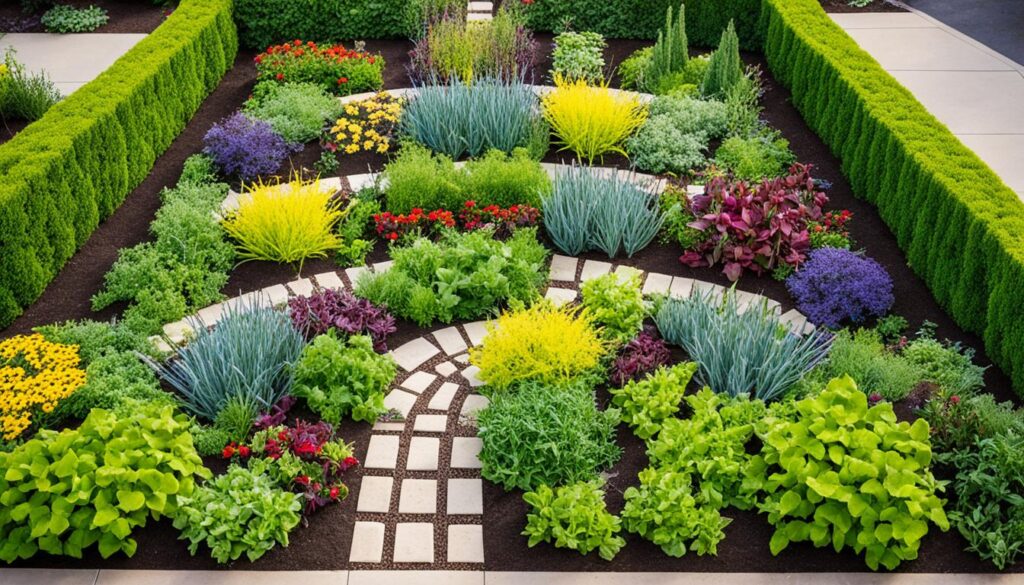
Preparing the Soil for Your Raised Garden Bed
One of the key advantages of building a raised garden bed is the ability to have complete control over the soil composition. This allows you to create the perfect growing environment for your plants. Properly preparing the soil for your raised garden bed is crucial for their success.
Here’s a step-by-step guide:
- Start by adding a few inches of existing soil from your garden to the bed. This will provide a base layer and help establish a connection between your raised bed and the ground.
- Next, layer 2 to 3 inches of high-quality planting mix on top of the existing soil. Select a planting mix that is well-draining and rich in organic matter.
- Use a shovel or garden fork to dig down into the soil and mix it with the planting mix thoroughly. This will help distribute nutrients evenly and break up any compacted soil.
- After mixing, it’s recommended to apply a high-phosphorus garden fertilizer. Phosphorus is essential for promoting healthy root development and flowering in plants.
- Once the fertilizer is applied, turn the soil one final time to ensure it is well-mixed and free of clumps.
Remember to regularly check the moisture levels in the soil, as raised beds can dry out more quickly than ground-level gardens. Water your plants as needed to maintain optimal moisture levels throughout the growing season.
A well-prepared soil mix in your raised garden bed will provide a nutrient-rich environment for your plants, helping them thrive and produce abundant harvests.
Benefits of Preparing the Soil in Your Raised Garden Bed
By carefully preparing your soil, you create an ideal growing environment for your plants. This results in healthier plants, improved yields, and a more enjoyable gardening experience overall.
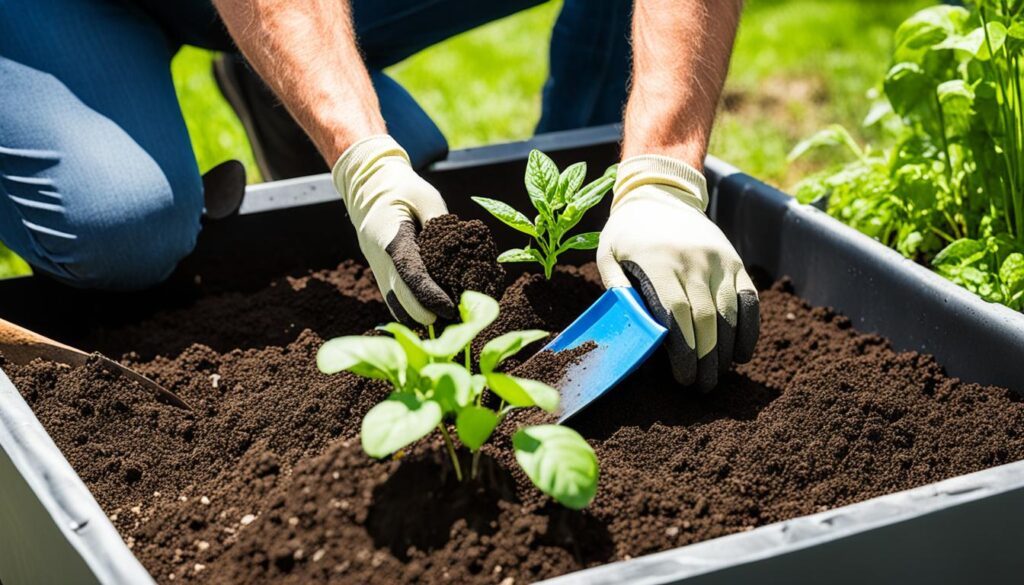
| Benefits of Preparing the Soil | |
|---|---|
| 1. Enhanced Nutrient Availability | Properly mixed soil provides a balanced nutrient profile, ensuring your plants receive the necessary minerals for growth and development. |
| 2. Improved Drainage | Mixing in planting mix helps create a well-draining soil structure, preventing waterlogged conditions that can lead to root rot. |
| 3. Weed Control | By preparing the soil thoroughly, you minimize the presence of weed seeds, reducing the need for frequent weeding. |
| 4. Soil Texture | Combining existing soil with planting mix improves the overall texture, providing better aeration and root penetration. |
| 5. Disease Prevention | Using clean planting mix reduces the risk of soil-borne diseases and pests that can harm your plants. |
Having a well-prepared soil mix will set the foundation for success in your raised garden bed. Take the time to properly prepare your soil, and reap the benefits of healthier plants and bountiful harvests throughout the growing season.
Irrigation and Pest Control in Raised Garden Beds
Raised garden beds require proper irrigation to ensure optimal plant growth. Consider using soaker hoses or drip irrigation systems to maintain consistent moisture levels. These irrigation methods deliver water directly to the roots, reducing water wastage and minimizing the risk of fungal diseases. Strategically placing the hoses or drip lines along the length of the bed will ensure a thorough and efficient watering system.
In addition to irrigation, implementing a pest control strategy is crucial for protecting your plants. Common garden pests, such as aphids, weevils, and leafhoppers, can wreak havoc on your crops if left unchecked. Weekly treatments with a suitable insecticide can help control these pests and safeguard the health of your plants.
“Proper irrigation and pest control are essential for the success of your raised garden beds.”
Remember to follow the instructions on the insecticide packaging carefully and wear protective gear, such as gloves and a mask, when applying the product. It’s also beneficial to regularly inspect your plants for any signs of pests or diseases and take necessary action promptly. Removing weeds and keeping the area around your raised garden beds clean can also help reduce the risk of pest infestations.
Frequently Asked Questions
- How often should I water my raised garden bed?
- Which insecticides are safe for use in raised garden beds?
- Are there natural pest control alternatives?
Expert Tip
Consider companion planting as a natural pest control method. Certain plants, when grown together, can deter pests or attract beneficial insects that prey on garden pests. For example, planting marigolds alongside your vegetables can deter aphids and nematodes, while attracting bees for pollination.
| Pest | Description | Control Methods |
|---|---|---|
| Aphids | Small, sap-sucking insects that can weaken plants and spread viruses. | Regularly inspect plants for aphids and control them with insecticidal soap or neem oil. |
| Weevils | Beetles with long snouts that feed on plant foliage and roots. | Apply a suitable insecticide and practice good garden hygiene to minimize weevil populations. |
| Leafhoppers | Small, hopping insects that feed on plant sap and leave behind stippling damage. | Use insecticidal soap or neem oil to control leafhoppers. Remove weeds that serve as alternative hosts for leafhoppers. |
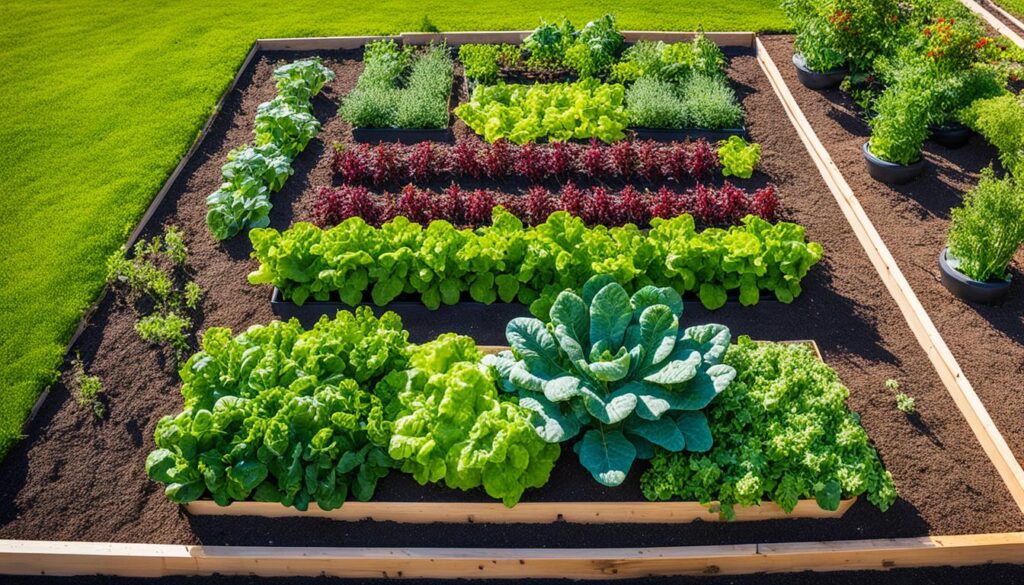
By maintaining proper irrigation and implementing effective pest control measures, you can ensure the success of your raised garden beds and enjoy abundant harvests.
The Benefits of Elevated Raised Bed Gardening
Elevated raised bed gardening combines the advantages of container gardening and traditional raised bed gardening. It eliminates the need for tilling, provides improved soil quality, offers better control of drainage and water retention, reduces soil compaction, and requires less maintenance. Additionally, elevated raised beds make gardening more accessible by raising the planting area to a comfortable working height.
If you’re considering starting a raised bed garden, opting for an elevated garden bed can offer even more benefits. These elevated beds are designed to be waist-height, eliminating the need for bending or kneeling while gardening. Not only does this make gardening more comfortable, but it also reduces strain on your back and knees, making it an ideal option for individuals with mobility issues or limited flexibility.
The elevated design of these beds also allows for easier access and maintenance. You can easily reach all parts of the bed without stepping on the soil, minimizing soil compaction. This is particularly important for root development and overall plant health. The raised height also helps to keep pests such as rabbits, slugs, and snails at bay.
Another advantage of elevated raised bed gardening is the improved soil drainage and water retention. The elevated design allows excess water to drain freely, preventing waterlogging and ensuring that plants receive the right amount of moisture. It also helps to protect the plants from flooding during heavy rains, reducing the risk of root rot and other water-related issues.
“Elevated raised beds offer the perfect solution for gardeners who want to enjoy the benefits of raised bed gardening while minimizing the physical strain associated with traditional gardening methods.”
– Gardening Expert, Jane Adams
Whether you have limited space, physical limitations, or simply want to take your gardening to new heights, elevated raised bed gardening is a game-changer. With its many benefits, elevated garden beds provide a convenient, productive, and enjoyable gardening experience.
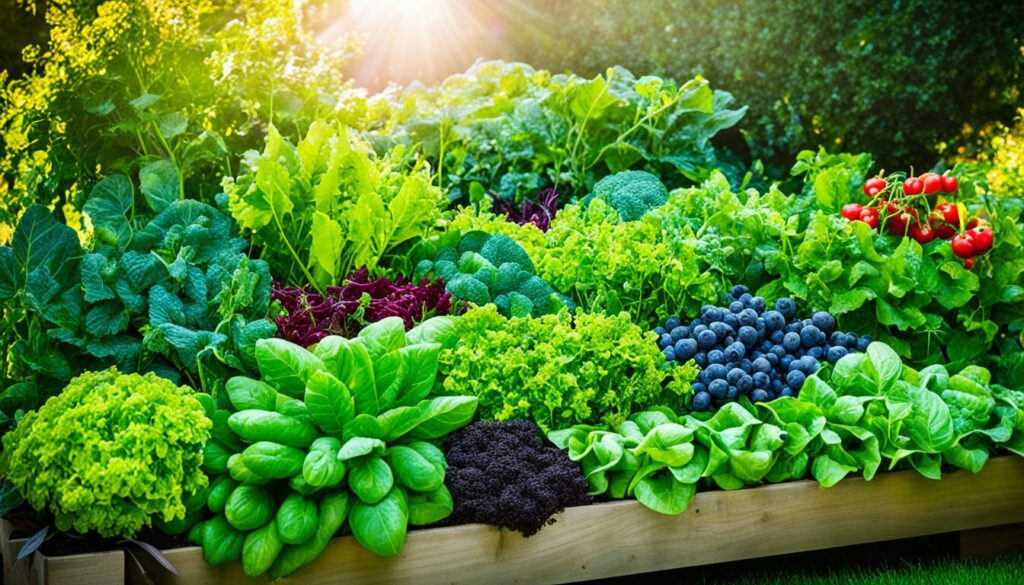
| Advantages of Elevated Raised Bed Gardening | Features |
|---|---|
| Eliminates the need for tilling | Less labor-intensive |
| Improved soil quality | Deeper, looser soil |
| Better control of drainage and water retention | Prevents waterlogging and root rot |
| Reduces soil compaction | Improved root development |
| Requires less maintenance | Less weeding and pest control |
| Makes gardening more accessible | Comfortable working height, easy access |
Selecting the Right Elevated Raised Bed
When it comes to choosing an elevated raised bed for your gardening needs, it’s essential to consider several factors to ensure the best results. The right planter can make a significant difference in the success of your raised bed gardening. Here are some key points to keep in mind:
1. Drainage and Weather Resistance
Look for an elevated raised bed that has proper drainage to prevent waterlogging and ensure optimal root health for your plants. Additionally, opt for planters made from weather-resistant materials to withstand the elements and provide long-lasting durability.
2. Size and Root System Accommodation
Consider the size of the planter in relation to the root systems of the plants you plan to grow. Ensure that the planter offers enough depth and space to accommodate the root growth, allowing your plants to thrive and develop properly.
3. Height for Ease of Use
Choose a planter height that suits your gardening preferences and physical comfort. Elevated raised beds are designed to bring the planting area to a more convenient height, reducing strain on your back and making gardening tasks more enjoyable.
4. Low-Maintenance Options
If you prefer low-maintenance gardening, select an elevated raised bed that requires minimal upkeep. Look for features such as weed barriers, self-watering systems, or options with built-in pest control measures to simplify the care and maintenance of your garden.
By considering these factors, you can select the right elevated raised bed that meets your gardening needs and ensures a successful raised bed gardening experience.
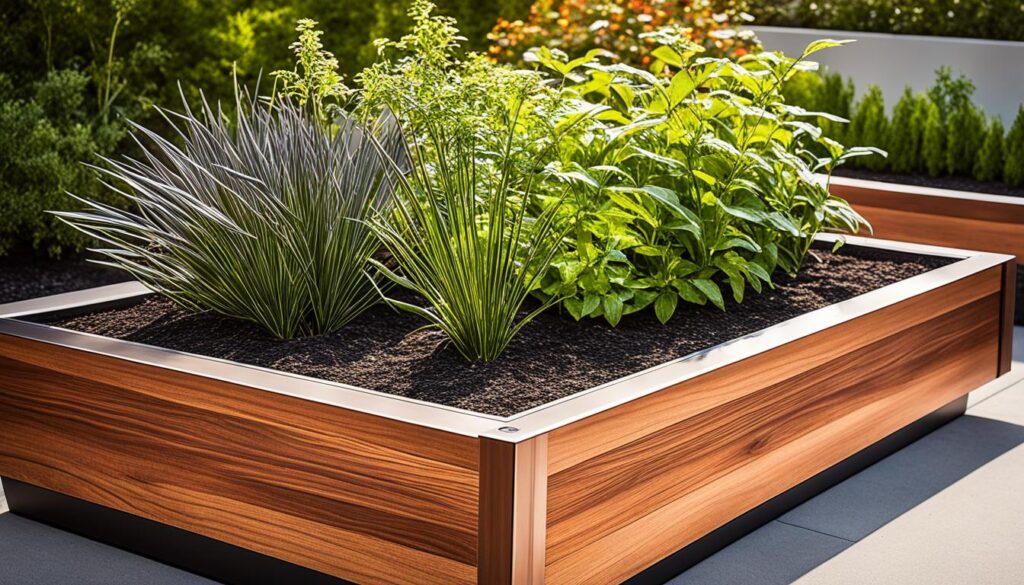
| Factors to Consider | Features to Look For |
|---|---|
| Drainage and Weather Resistance | Proper drainage system Weather-resistant materials |
| Size and Root System Accommodation | Adequate depth and space for root growth |
| Height for Ease of Use | Comfortable working height |
| Low-Maintenance Options | Weed barriers Self-watering systems Built-in pest control measures |
Placing and Filling Your Elevated Raised Bed
Now that you’ve chosen your elevated raised bed, it’s time to find the perfect spot for it in your garden. Select a location that receives at least 6 to 8 hours of full sun per day to ensure optimal plant growth. Sunlight is crucial for the development of healthy and productive plants.
Additionally, it’s essential to place your elevated raised bed close to a water source. This will make watering your plants more convenient and efficient, especially during hot summer months. Consider installing a drip irrigation system or using a watering can to ensure your plants receive the right amount of moisture.
Once your elevated raised bed is in position, it’s time to fill it with the right soil mix. To create a nutrient-rich environment for your plants, use a mixture of high-quality potting soil and compost. This combination will provide the necessary nutrients and improve the overall soil structure, promoting healthy root growth.
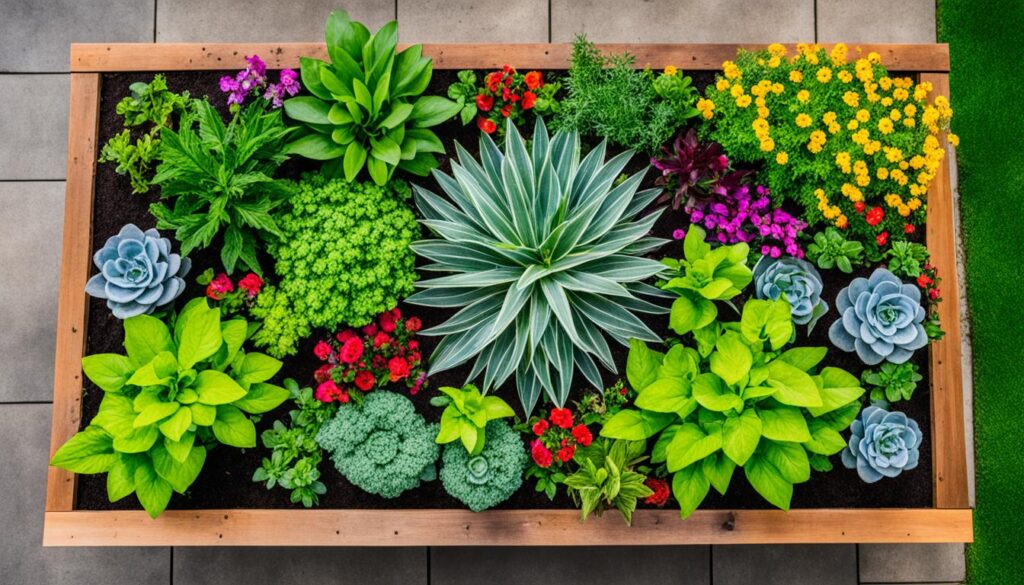
It’s important to ensure that the planter is deep enough to accommodate the root systems of your chosen plants. Adequate depth will allow the roots to spread and access the necessary nutrients and water. Aim for a depth of at least 12 to 18 inches to provide ample space for root growth.
As you fill your elevated raised bed, gently pat down the soil to remove any air pockets and create a level surface. This will aid in the even distribution of water and promote healthy plant growth.
With your elevated raised bed in place and filled with nutrient-rich soil, you’re now ready to start planting your favorite flowers, herbs, or vegetables. Enjoy the convenience and benefits of elevated bed gardening as you watch your plants thrive in their elevated environment.
Conclusion
Raised garden beds are a game-changer for any gardener. With their improved drainage, better soil quality, and reduced maintenance, they offer numerous benefits. By following the tips and ideas shared in this article, you can easily create your own DIY raised garden bed and take your gardening experience to the next level.
Imagine the satisfaction of growing your own plants and enjoying bountiful harvests right in your backyard. With a raised garden bed, you have full control over the soil composition and can create the perfect environment for your plants to thrive. Say goodbye to back-breaking weeding and bending over for hours – working in a raised garden bed is a comfortable and enjoyable experience.
Start planning your raised garden bed today. Consider the right materials, choose a suitable design, and prepare the soil accordingly. Whether you opt for a traditional raised bed or an elevated option, the benefits will be worth it. Embrace the joy of growing your own vegetables, herbs, and flowers with a beautiful and functional raised garden bed.
FAQ
What are the benefits of raised garden beds?
Raised garden beds offer advantages such as improved drainage, better soil quality, reduced maintenance, and easier access to plants.
What materials can I use to build a raised garden bed?
Common materials for raised garden beds include wood (such as cedar or cypress), cinderblocks, and landscape stones. Consider the durability and rot-resistance of the materials when making your selection.
How should I plan and design my raised garden bed?
Opt for rectangular beds that are no wider than 4 ft to allow for easy access to plants. Consider the depth and overall layout of your bed, as well as the placement in your outdoor space.
How do I prepare the soil for my raised garden bed?
Start by adding a few inches of existing soil to your bed, followed by 2 to 3 inches of planting mix. Mix the soil with the planting mix and apply a high-phosphorus garden fertilizer. Regularly check the moisture levels in the soil, as raised beds can dry out quickly.
How can I irrigate and control pests in my raised garden bed?
Consider using soaker hoses or drip irrigation systems for proper irrigation. Implement a pest control strategy by using suitable insecticides to control common garden pests like aphids, weevils, and leafhoppers.
What are the benefits of elevated raised bed gardening?
Elevated raised bed gardening combines the advantages of container gardening and traditional raised bed gardening. It offers benefits such as eliminating the need for tilling, improved soil quality, better drainage control, reduced soil compaction, and less maintenance.
How do I choose the right elevated raised bed?
When selecting an elevated raised bed, consider factors such as drainage, durability, size, and maintenance requirements. Look for a planter with proper drainage and made from weather-resistant, food-safe materials. Ensure that the size of the planter can accommodate the root systems of your chosen plants.
Where should I place and fill my elevated raised bed?
Choose a location that receives at least 6 to 8 hours of full sun per day for optimal plant growth. Ensure that the planter is close to a water source for easy watering. Fill the planter with a mixture of high-quality potting soil and compost, ensuring that it is deep enough to accommodate the root systems of your chosen plants.
